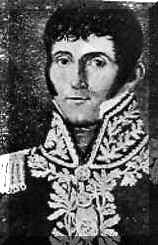General Jean-Louis-Brigitte Espagne

Born: February 16, 1769
Place of Birth: Auch, Gers, France
Died: May 21, 1809
Cause of Death: Killed in action
Place of Death: Aspern-Essling, Austria
Arc de Triomphe: DESPAGNE on the east pillar
Pronunciation:
A distinguished heavy cavalry officer, Jean-Louis-Brigitte Espagne's career in the military began in 1787 when he enlisted in the Queen's Dragoons. With the Revolution heating up in 1792, he was assigned in the Army of the North and by the end of the year he had risen to become a lieutenant colonel. In November of 1792 Espagne also found time to be a witness at the wedding of his friend Alexandre Dumas.1 In 1793 Espagne received a promotion to chef de brigade and he served in the Army of the Western Pyrenees. The following year Espagne joined the Army of the Alps as an aide-de-camp to his friend Dumas, and he went on to distinguish himself in the fighting at Mont Cenis. After serving in different armies for the rest of the year, he joined General Jourdan's staff in the Army of the Sambre and Meuse.
In December of 1796 Espagne took command of the 8th Cavalry and he distinguished himself at the passage of the Rhine at Neuwied in April of 1797. After serving a short stint in the Army of Germany, he then joined the Army of Mainz and served under General Hatry. A promotion to général de brigade finally came for Espagne in July of 1799, and later that year he began to serve in the Army of the Rhine under first Lecourbe and then Moreau. Taking command of a brigade of carabiniers in d'Hautpoul's division, in the year 1800 he fought at Messkirch and Hochstaedt before being wounded in the arm at Neubourg. After a brief period of peace, in December Espagne served at the Battle of Hohenlinden where he commanded a brigade of the cavalry reserve and contributed to the victory. After that victory he went on to fight at Erding before hostilities were ceased.
With peace finally achieved, General Espagne was temporarily put on non-activity in 1801 before he was employed in the 21st military division as commander of the department of Haute-Vienne. Four years later in 1805 he received a promotion to général de division and took command of a cavalry division of the Army of Italy. Leading his men into action during the campaign in Italy of that year, Espagne fought at San-Michele and Caldiero and then seized Gradisca. In 1806 he commanded the province of Labour, and his men defeated and captured the bandit Fra Diavolo.
Returning to the main force of La Grande Armée in November of 1806, Espagne took command of the 3rd Division of Cuirassiers and took part in the Siege of Danzig the following March. After concluding the siege, he and his men joined Marshal Murat's cavalry reserve. Espagne led his division into battle at the Battle of Heilsberg where he was wounded. In recognition of his service, he was named a Grand Officer of the Legion of Honor the next month. Another reward came in 1808 when he was named a Count of the Empire.
Espagne's division of cuirassiers was next stationed in Germany under the overall command of Marshal Davout. When the Austrians attacked in the spring of 1809, Espagne's division became part of Marshal Lannes' II Corps and they took part in the Danube campaign. During the first day of the Battle of Aspern-Essling , Espagne's cocked hat was shot and damaged, and in response he simply turned his hat so the undamaged side faced the front.2 Unfortunately, later in the day he was directly hit, and bleeding profusely, he was transported to the isle of Lobau by his men. He died within a matter of minutes.
Notes
- Tom Reiss, The Black Count: Glory, Revolution, Betrayal, and the Real Count of Monte Cristo, (New York: Crown Publishers, 2012), 140.
- Philip J. Haythornthwaite, Who Was Who in the Napoleonic Wars, (London: Arms & Armour, 1998), 112.
Bibliography
- Haythornthwaite, Philip J. Who Was Who in the Napoleonic Wars. London: Arms & Armour, 1998.
- Six, Georges. Dictionnaire Biographique des Généraux & Amiraux Français de la Révolution et de l'Empire (1792-1814). 2 vols. Paris: Gaston Saffroy, 2003.
Related Pages:
External Links:
Updated August 2017
© Nathan D. Jensen